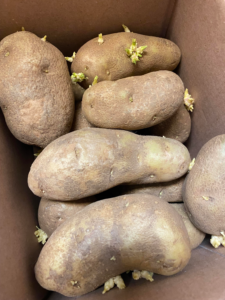Finding potatoes with sprouts in your pantry is quite common, especially if they’ve been stored for an extended period. But when you see those shoots starting to emerge, it’s natural to wonder if those potatoes are still safe to eat. Let’s dive into what you need to know about sprouted potatoes, whether they can be eaten, and how to handle them properly.

What Happens When Potatoes Sprout?
Potatoes sprout when they begin to grow shoots, often referred to as “eyes,” in an attempt to reproduce. This usually happens when potatoes are exposed to light, warmth, or have simply been sitting around for too long. Although the sprouting process itself is not inherently dangerous, it does impact the quality and safety of the potato.
Sprouting is essentially the potato transitioning into a growth phase, as it uses its stored nutrients to produce new shoots. During this process, potatoes may develop green spots or areas, which indicate an increased concentration of certain natural compounds that may be harmful.
Are Sprouted Potatoes Safe to Eat?
The answer depends on the condition of the potatoes and how they’re handled. Here are some key points to consider if you’re thinking about eating sprouted potatoes:
- Remove the Sprouts and Green Areas:
If you notice your potatoes have sprouted, they can still be used as long as you remove the sprouts and any green areas. The sprouts and green spots contain solanine, a natural toxin that potatoes produce as a defense mechanism. Consuming high levels of solanine can be harmful and may lead to symptoms like nausea, headaches, or digestive discomfort. Removing the sprouts and trimming off the green areas can help reduce the risk. - Check for Spoilage:
Beyond sprouting, it’s important to check for other signs that indicate whether the potato is spoiled. If the potato feels soft, looks shriveled, or has a strong, unpleasant odor, it’s best to discard it. A potato that shows these signs has likely lost its quality and could pose a health risk if consumed. - Cook Thoroughly:
Cooking sprouted potatoes thoroughly can help lower the solanine content, making them safer to eat. However, it is advisable not to consume large quantities of sprouted potatoes, particularly those with significant green discoloration. While cooking helps, it doesn’t eliminate all the risks, especially if solanine levels are high. When in doubt, it’s better to be cautious and discard heavily sprouted or green potatoes.
Why Are Sprouted Potatoes a Concern?
The main issue with sprouted potatoes is the presence of solanine, a toxic compound that forms as part of the potato’s natural defense against pests. Solanine levels increase when potatoes are exposed to light or stored in less-than-ideal conditions, leading to the development of green patches on the skin. Consuming too much solanine can cause a range of symptoms, from mild digestive discomfort to more serious effects like headaches and nausea. The green color on a potato is a clear visual indicator of increased solanine, which is why it’s crucial to remove these parts before cooking or eating.
How to Prevent Potatoes from Sprouting
To avoid dealing with sprouted potatoes altogether, proper storage is key. Here are some tips to help prevent your potatoes from sprouting:
- Store in a Cool, Dark Place:
Potatoes should be kept in a cool, dark environment with good ventilation to prevent sprouting. Exposure to light accelerates the production of solanine and causes potatoes to turn green. A pantry, cellar, or any place that remains cool and dark is ideal for storing potatoes. It’s also important to avoid storing potatoes in the refrigerator, as the cold temperature can affect the starch in the potatoes, leading to a change in flavor and texture. - Use Proper Storage Containers:
Store potatoes in breathable containers, such as paper bags, baskets, or cloth bags. Plastic bags should be avoided because they trap moisture, which can speed up the sprouting process and lead to spoilage. Proper air circulation helps keep potatoes fresh for a longer period. - Keep Away from Onions:
Potatoes and onions should not be stored together, as onions release gases that can promote sprouting in potatoes. Keeping them apart can extend the shelf life of both. - Monitor Regularly:
Make it a habit to regularly check your potatoes for signs of sprouting or spoilage. Using the potatoes before they start to sprout or develop green spots ensures you get the best quality and taste while minimizing potential health risks.
Conclusion
Sprouted potatoes can be safe to eat if you handle them carefully. The key is to remove all sprouts and any green areas that contain solanine, a potentially harmful toxin. Always check your potatoes for signs of spoilage, such as softness or a bad odor, and discard any that seem questionable. Properly storing your potatoes in a cool, dark place and keeping them away from onions can help prevent sprouting in the first place.
While cooking sprouted potatoes thoroughly can reduce the risks, it’s still wise not to consume them in large quantities, particularly if the green areas are extensive. If there is any doubt about their safety, it’s best to err on the side of caution and discard them. The potential health risks from solanine exposure simply aren’t worth it.
Potatoes are a versatile and nutritious staple in many households, and with a little attention to storage and handling, you can continue to enjoy them safely. Next time you notice your potatoes starting to sprout, don’t panic—just assess their condition, remove the problematic parts, and cook them properly. By following these guidelines, you can ensure that your potatoes are safe to eat and continue to be a delicious part of your diet.





